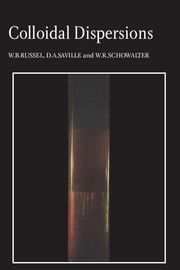Book contents
- Frontmatter
- ACKNOWLEDGEMENTS
- Contents
- Preface
- Units and physical constants
- Mathematical symbols
- 1 A Survey of Colloidal Dispersions
- 2 Hydrodynamics
- 3 Brownian Motion
- 4 Electrostatics
- 5 Dispersion forces
- 6 Forces due to soluble polymer
- 7 Electrokinetic phenomena
- 8 Electrostatic stabilization
- 9 Polymeric stabilization
- 10 Equilibrium phase behavior
- 11 Particle capture
- 12 Sedimentation
- 13 Diffusion
- 14 Rheology
- Appendix A Measured properties
- Appendix B Vector and tensor notation
- Author index
- Subject index
14 - Rheology
Published online by Cambridge University Press: 05 August 2012
- Frontmatter
- ACKNOWLEDGEMENTS
- Contents
- Preface
- Units and physical constants
- Mathematical symbols
- 1 A Survey of Colloidal Dispersions
- 2 Hydrodynamics
- 3 Brownian Motion
- 4 Electrostatics
- 5 Dispersion forces
- 6 Forces due to soluble polymer
- 7 Electrokinetic phenomena
- 8 Electrostatic stabilization
- 9 Polymeric stabilization
- 10 Equilibrium phase behavior
- 11 Particle capture
- 12 Sedimentation
- 13 Diffusion
- 14 Rheology
- Appendix A Measured properties
- Appendix B Vector and tensor notation
- Author index
- Subject index
Summary
Introduction
In the preceding chapters we have examined the response of colloidal particles to interactions with one another in a quiescent fluid, to interactions with large collectors while being convected by the fluid, and to imposed forces due to electric fields, gravity, or concentration gradients. In each case, equilibrium or non-equilibrium, static or dynamic, the interparticle forces and the resulting suspension microstructure play key roles. Now we consider the stresses and the non-equilibrium microstructure generated in a flowing suspension when the velocity varies spatially on a scale large with respect to the size of the particles.
A Newtonian incompressible liquid is characterized by a linear relation between the stress tensor and the rate-of-strain tensor, with the constant of proportionality being the viscosity. Polymeric liquids are well known for their non-Newtonian behavior including shear-rate-dependent viscosities, elasticity manifested in recoil upon the cessation of flow, solid-like fracture during extrusion, and a variety of secondary flow phenomena. Colloidal suspensions also depart from Newtonian behavior. They often behave as solids requiring a finite stress, the yield stress, before deforming continuously as a liquid. The contrast with the polymeric liquids reflects the fundamentally different microstructures. Both microstructures deform under stress, but macromolecular systems can recover from strains of several hundred per cent because the restoring force increases with the degree of deformation. The interparticle forces governing the microstructure in colloidal dispersions generally have a short range and the magnitude decreases with increasing separation, providing no mechanism for recovery beyond strains of a few per cent.
Information
- Type
- Chapter
- Information
- Colloidal Dispersions , pp. 456 - 506Publisher: Cambridge University PressPrint publication year: 1989
Accessibility standard: Unknown
Why this information is here
This section outlines the accessibility features of this content - including support for screen readers, full keyboard navigation and high-contrast display options. This may not be relevant for you.Accessibility Information
- 10
- Cited by
